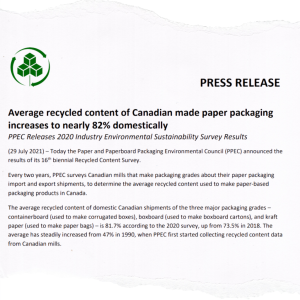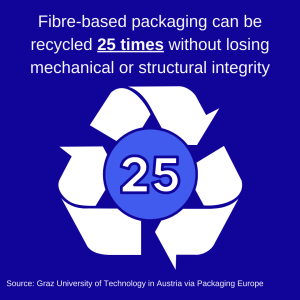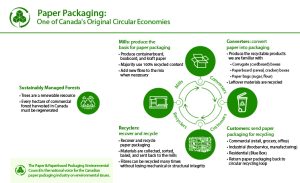There have been a lot of recent developments related to Canada’s Zero Plastic Waste Agenda and the federal government’s ban on single-use plastic products, which is why it is a perfect time to share this blog examining some of the latest news, key activities, and the potential impacts on the paper packaging industry.
Ban on single-use plastic
On June 22, the Single-use Plastics Prohibition Regulations were published, which prohibit the manufacture, import, sale, and export of the following single-use plastic items: checkout bags, cutlery, foodservice ware made from or containing problematic plastics, ring carriers, stir sticks and straws.
The ban comes into effect December 2022, with sale of the prohibited items effective December 2023, and the ban on exporting the prohibited plastics by the end of 2025.
There are some exceptions to the ban, which are outlined in this technical guidance document.
Consultations on plastics labelling rules and data collection
On July 25, the federal government launched two consultations related to their work on combating plastics pollution, including the development of labelling rules for recyclability and compostability, and the development of a federal plastics registry.
The government\’s news release, Government of Canada takes next steps forward on better plastic recyclability, compostability, and tracking and associated backgrounder, states that \”Labels on plastic packaging that claim recyclability or compostability are often inaccurate,\” – speaking of which, have you read PPEC\’s blog on environmental claims? – and that new rules would prohibit the use of the recycling symbol, and other claims, unless at least 80% of Canadians have access to recycling systems that accept plastic packaging and have end markets for them.
The government also intends to regulate the use of terms such as “compostable,” “degradable,” and “biodegradable” in the labelling of plastic packaging and single-use items; and plans to develop a registry that would require producers to report annually on the quantity of plastic products they place on the Canadian market, and how these products are diverted from landfills after use.
Plastics ban and paper packaging
Going back to the single-use plastics ban, the government’s guidance document for selecting alternatives provides info on how to transition away from the banned items, offering that plastics could be reduced by using other materials including wood, paper, and moulded pulp fibre.
So, what does this mean for paper-based packaging?
Both from a broader perspective, but also with regards to the specific newly banned items, there is a market shift towards using more sustainable and renewal packaging materials. Companies such as P&G, Carlsberg, Amazon, McDonald’s, and Nestlé, to name a few, have all recently made announcements regarding changes in some of their packaging, with a clear shift towards paper-based packaging.
This ban will likely see that trend continue, and groups like Fisher International believe the Pulp and Paper industry has an opportunity to step in to provide alternatives, which they wrote about in Canada’s New Plastic Ban Could Drive Renewed Interest in the P&P Industry. While their article raises a lot of important questions for the industry to consider – such as impact on future pulp prices, capital investment needs, and the state of sustainably-managed forest supply – it doesn’t speak directly to the environmental attributes of paper-based packaging, so let’s take a minute to talk about that.
The major paper packaging grades made in Canada – corrugate boxes, paperboard boxes, and paper bags – are produced primarily with recycled content. While the paper fibres originally come from trees, hardly any of Canada’s commercial forests are harvested for paper packaging; and by law, every hectare that is harvested in Canada must be successfully regenerated.

A mill produces the material used to make paper packaging, using mainly recycled content, and then a converter turns it into paper packaging. After having used the packaging, the customer recycles it, and the recycled product goes back to the mill, where it is remade into new paper-based packaging. And the cycle repeats itself again and again.
Just how many times is ‘again and again’? Initial research had shown that paper could be recycled up to seven times, and corrugated box fibres up to ten times, but a recent study from the Graz University of Technology in Austria found that fibre-based packaging material can be recycled at least 25 times without losing mechanical or structural integrity.

When it comes to residential recycling programs that accept paper-based packaging, we know that 96% of Canadians have access to recycling for corrugated boxes and paper bags, and 94% for boxboard cartons, determined through an independent third-party study commissioned by PPEC.
For recycling, PPEC has estimated a national recovery rate for corrugated boxes of at least 85%, with recycling even higher in certain provinces, such as Ontario’s residential Blue Box program, which has a 98% recovery rate for corrugated (according to the most recent pay-in-model information previously made available from Stewardship Ontario).
In 2019, it was estimated that Canada generated 1.89 million tonnes of plastic packaging, of which 12% was recycled, according to research from the Canada Plastics Pact (CPP).
While we know efforts are underway to transition to a more circular economy for plastic packaging in Canada by groups like the CPP, PPEC is proud that paper packaging is one of Canada’s original circular economies.

